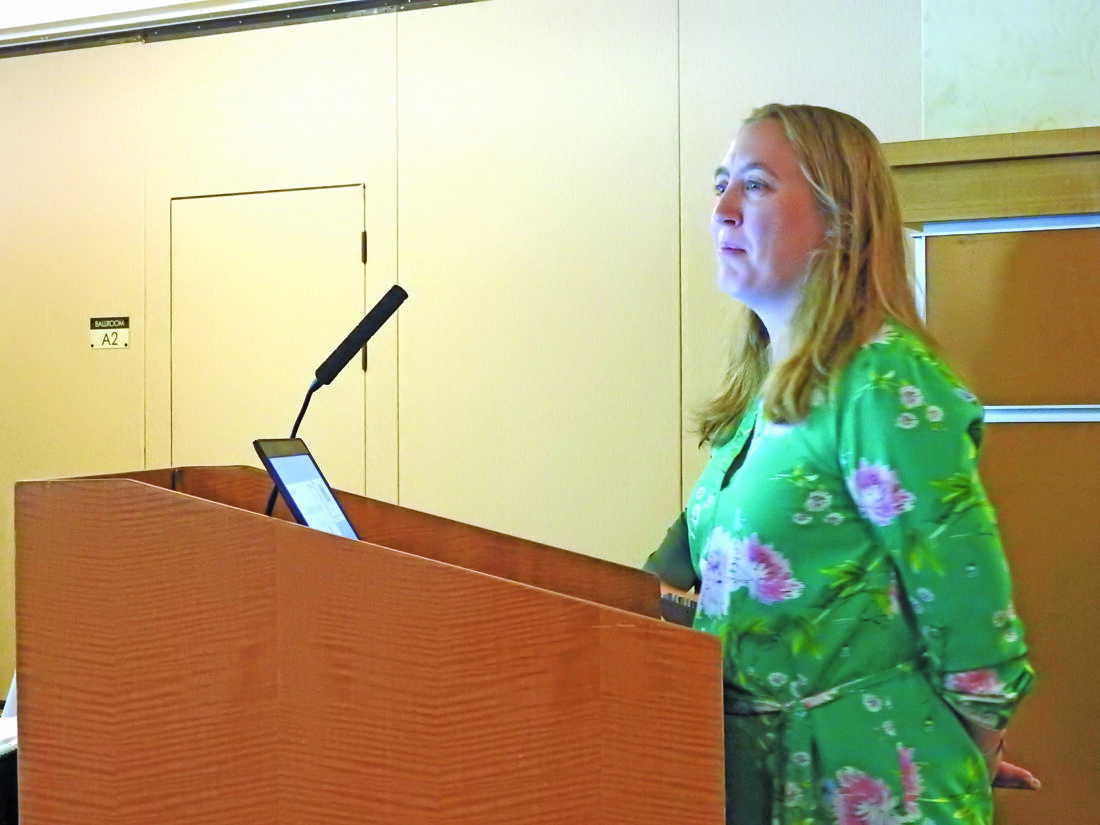MTU working to improve flu vaccines

Garrett Neese/Daily Mining Gazette Michigan Technological University Health Research Institute Director Caryn Heldt talks about her team’s work to improve the manufacturing of flu vaccines during Friday’s Board of Trustees meeting.
HOUGHTON – Most flu vaccines are grown in eggs, requiring one for each dose.
Michigan Technological University Health Research Institute Director and chemical engineering Caryn Heldt and her team are studying ways to make a better-performing flu vaccine that is produced faster and more cheaply.
Current flu vaccines are live-attenuated, where it is grown in animals so as not to affect humans. They provoke the strongest immune response, but also have the most side effects.
The annual flu shot typically contains four varieties of flu vaccine, each requiring three or four eggs. Those eggs also need to be the same age, as measured in days, Heldt said.
“This can get better, because not only does it take a lot of eggs, since these vaccines grow in eggs, then they don’t always create the immune response we need for the human vaccine, because it’s grown in eggs and so it prefers chickens,” she said.
Standard flu vaccines can be anywhere from 30% to 70% effective in a given year, Heldt said.
What could replace them? Heldt is interested in recombinant virus-like particles (VLP). These are proteins arranged in a round shape similar to a virus, which the body responds to in a similar fashion.
To make generating antibodies more likely, Heldt would take cells, put them in a bioreactor, and then purify it.
The cells — mammalian, insect, yeast or bacteria — would have a virus added. Even after growing in the cells, the virus only makes up about 1% of the mixture at first. It would then be concentrated and purified until it makes up about 95%.
Purification accounts for about 70% of the cost of vaccine manufacturing, Heldt said. And it only produces recovery of 30% to 50%.
“You can improve things a lot if you just improve those yields a little bit,” Heldt said.
The lab recently purchased a bioreactor, which should be arriving in the next six months, Heldt said. Today’s bioreactors use single-use plastic bags, some of which are as large as 5,000 liters. They’re actually better for the environment than the previous standard of stainless steel bioreactors, which had to be cleaned and sterilized after each use, Heldt said.
“It’s really pretty colors because those are pH indicators, so you know how well the cells are living,” she said. So everything’s pretty pink and oranges, and it’s really fun to be in these systems.”
They’re more efficient than eggs. A bioreactor the same size can produce 1,000 doses of flu vaccine, Heldt said.
One cell vaccine, Flucelvax, is already on the market. But after 10 years, it’s only secured 15% of the market, Heldt said. Why? At about $30 a dose, it’s twice as expensive.
To make it cheaper, Heldt’s lab is working to transform the process from batch to continuous.
It allows for a smaller footprint, as well as being faster to build and using fewer resources.
“This has been done in many, many industries,” Heldt said. “And it’s now the time for the bioindustry to take on this challenge.”
While they’ve had success in making the upstream process of replicating the virus continuous, purification has been trickier, Heldt said. The system being built by the lab uses liquid-liquid extraction. The lab commissioned its second single-pass filtration unit this week.
“So now that is easy to flow in, flow out and continuously flow compared to other methods,” she said. “…This is kind of one of our unique contributions to vaccine manufacturing.”
Heldt’s lab is also working on formulation, or how a vaccine is stabilized. Right now, that usually requires super-cold temperatures; for instance, the Pfrizer COVID-19 vaccine needed to be kept at -80 degrees Celsius. When those vaccines were first being delivered to the area, many were kept in freezers at Tech because some area hospitals didn’t have freezers that could store them at that low a temperature.
Before the pandemic, about 50% of vaccines were lost because of the difficulties of maintaining the vaccine “cold chain,” Heldt said.
“I often use the analogy that if you are going to eat a steak, you would never take that steak, throw it on the counter, leave it there for three days, and then cook it up,” she said. “These vaccines are made out of the same thing. They’re made out of proteins. And so it’s really hard to stabilize that.”
Eventually, Heldt wants to make “shelf-stable” vaccines that could be kept at room temperature.
Heldt’s team is working on ways to add peptides to create a dense liquid phase that can thermally stabilize vaccines and viruses.
Tech is partnering with foundations, industry and agencies including the National Institute of Health, Food and Drug Administration and the National Science Foundation.
“And really we’re pushing forward to be able to improve vaccine manufacturing,” Heldt said.
The team is looking at licensing and patenting its process, and is also discussing a start-up company, Heldt said.
Board members complimented Heldt on the presentation and the project.
“I am truly humbled by the expertise that is inside this university,” said board Chair Jeffrey Littman.






